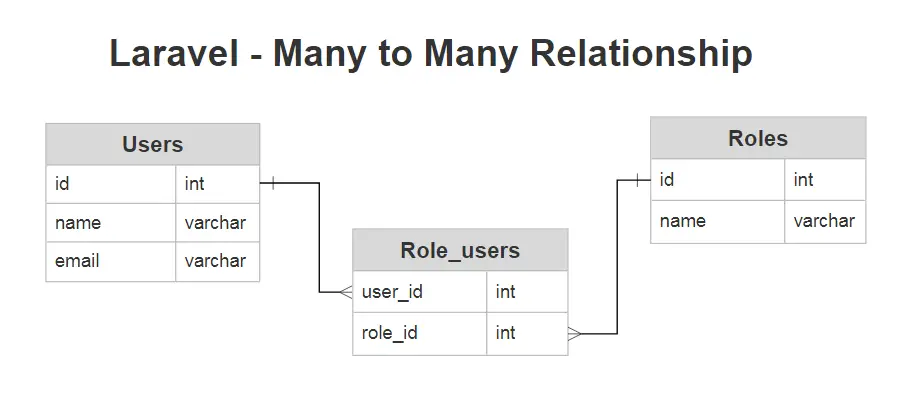Laravel 8 Many To Many Relationship Example
In this article, we will see laravel 8 many to many relationship example. Use many to many relationship in laravel 6 and laravel 7 and laravel 8. Many to many relationships are more complicated than one to one and one to many relationships. An example of like a relationship is a user with multiple roles, where the role are also connected with multiple users.
So, let's see many to many relationship in laravel 8 or laravel 8 eloquent relationships.
Also, we will create migration with a foreign key, sync with a pivot table, retrieve records using the model, insert new records, update records, etc. We will create a User and Roles and Role_users table. all tables are connected with each other table. Now we will create many to many relationships with each other by using the laravel Eloquent Model.

Now, we have to create migration for users and roles and role_users table. we will also add a foreign key with the users and roles table.
Create Migration of Users Table
Schema::create('users', function (Blueprint $table) {
$table->increments('id');
$table->string('name');
$table->string('email')->unique();
$table->timestamps();
});
Create Migration of Roles Table
Schema::create('roles', function (Blueprint $table) {
$table->increments('id');
$table->string('name');
$table->timestamps();
});
Create Migration of Role Users Table
Schema::create('role_users', function (Blueprint $table) {
$table->integer('user_id')->unsigned();
$table->integer('role_id')->unsigned();
$table->foreign('user_id')->references('id')->on('users')->onDelete('cascade');
$table->foreign('role_id')->references('id')->on('roles')->onDelete('cascade');
});
Now, we will create a User, Role model. we will use the belongsToMany() relationship of both models.
User Model:
<?php
namespace App\Models;
use Illuminate\Database\Eloquent\Model;
class User extends Model
{
/**
* Get the phone associated with the user.
*/
public function roles()
{
return $this->belongsToMany(Role::class, 'role_users');
}
}
Role Model:
<?php
namespace App\Models;
use Illuminate\Database\Eloquent\Model;
class Role extends Model
{
public function user()
{
return $this->belongsToMany(User::class, 'role_users');
}
}
Once the relationship is defined, we may retrieve the related record using Eloquent's dynamic properties.
$role = User::find(1)->roles;
$user = Role::find(1)->users;
Now, we will create records using the attach() function.
$user = User::find(1);
$role_ids = [1, 2];
$user->roles()->attach($role_ids);
$user = User::find(3);
$role_ids = [1, 2];
$user->roles()->sync($role_ids);
You might also like:
- Read Also: How To Avoid TokenMismatchException On Logout In Laravel
- Read Also: How To Integrate Paypal Payment Gateway In Laravel 8
- Read Also: Laravel 8 Form Validation Example
- Read Also: Laravel REST API CRUD Tutorial








